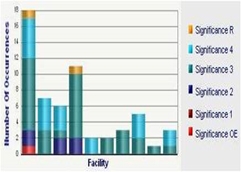CORPORATE REPORTING AND SAFETY PERFORMANCE ANALYSIS

The Office of Environment, Health, Safety and Security (EHSS) manages corporate reporting databases and provides analysis of DOE-wide performance in protecting the public, the workers and the environment while performing the missions of DOE. EHSS manages a number of viable safety indicators applicable to most DOE contractor operations that provide Departmental leadership, line management, and stakeholders with timely information to gauge the success of Departmental safety program implementation. This analysis is valued in corporate decision-making and synthesizes operational information to support continuous environment, safety and health (ES&H) improvement across the DOE complex. Safety performance indicators and trends are developed and analyzed utilizing DOE operational and occurrence data collected through various reporting mechanisms and provided through Internet-based tools and databases.
CORPORATE REPORTING DATABASES
Comprehensive Epidemiologic Data Resource (CEDR) System: CEDR is a DOE public-use repository of data from occupational and environmental health studies of workers at DOE facilities and nearby community residents. Contact: Cliff Strader
Computerized Accident/Incident Reporting System (CAIRS): This system collects and analyzes DOE and DOE-contractor reports of injuries, illnesses, and other accidents that occur during DOE operations. Contact: Janet Macon
DOE Corporate Lessons Learned (LL): The DOE Corporate Lessons Learned database is a web-based lessons learned (LL) system designed to facilitate the sharing of lessons learned and best practices in a consistent and timely manner across the complex to prevent recurrence of significant adverse operational events and trends and to improve performance. Contact: Ashley Ruocco
Fire Protection: DOE O-231.1, Environment, Safety, And Health Reporting, requires the submission of an Annual Fire Protection Summary. Data collection and a commitment has been made to the Defense Nuclear Facilities Safety Board to collect information and make it available utilizing a standard systematic approach. This approach is accomplished via a web-based system which will allow reporting organizations to enter or edit information. Use of the web interface requires registration. Contact: John Stirling
Occurrence Reporting and Processing System (ORPS): This system provides timely notification to the DOE complex of events that could adversely affect public or DOE worker health and safety, the environment, national security, DOE's safeguards and security interests, functioning of DOE facilities, or the Department's reputation. Contact: Ashley Ruocco
Pollution Prevention (P2): This site announces P2-related news and developments, as well as providing a convenient on-line reporting system to the DOE sites and program offices. Contact: Josh Silverman
Radiation Exposure Monitoring System (REMS): The REMS database tracks occupational radiation exposures for all monitored DOE employees, contractors, subcontractors and members of the public. A password is not needed to access this database. Contact: Nimi Rao
Radiological Source Registry and Tracking (RSRT)
The RSRT is a DOE database that is maintained by the Office of Environment, Health, Safety and Security (EHSS), Office of Information Management (AU-72). The annual 10 CFR 835 Appendix E inventory data, and the transaction and verification information for Category 1 and 2 radioactive sealed sources will be reported to the RSRT Manager. Additional guidance for reporting transactions for Category 1 and 2 sources to the DOE RSRT is provided in the December 16, 2010 Chief Health, Safety and Security Officer memorandum, Reporting for Radiological Sealed Sources Transactions. The RSTS Manager is responsible for reporting the transaction to the NRC NSTS. Contact: Joe Vital
Safety Basis Information System (SBIS): The SBIS database contains safety information from DOE nuclear facilities. The SBIS website provides access to the following items: 1) the Public Access Safety Basis Report; 2) the SBIS database (restricted password protected access for DOE and DOE contractors only); and 3) the SBIS account request page. Contact: Nimi Rao
Suspect/Counterfeit and Defective Items: The Department of Energy is committed to ensuring that items and components installed in safety-related or mission-critical applications meet their intended function and operability requirements. Therefore, EHSS has established a process for identifying Suspect/Counterfeit (S/CI) or Defective Items (DI) that are deemed safety-significant and broadly applicable to DOE facilities and for ensuring that action is taken. Contact: Deborah Garnett-Harris
CLASSIFIED DATABASES/ASSETS
- Electronic Classification Guidance System (eCGS/xCGS): eCGS/xCGS contains full texted indexed versions of all DOE classification guides which can be searched on any word or phrase in all of the guides.
- ePub- Classification Guidance Authoring and Publishing System: ePub is used to edit and publish DOE classification guides and stores DOE classification guides in XML format.
- Patent Application Classification Analysis System (PACAS): PACAS stores information regarding US patents classified due to RD-related content. PACAS is not currently being used and may be decommissioned in the future.
- Safeguards and Security Information Management System (SSIMS): SSIMS is the master repository for information on DOE and DOE contractor classified facilities based on O 470.4, M 470-4-4, and M 47.0.4-1.
- Reviewers Electronic Library, Knowledge Preservation Library (REL/KPL): REL/KPL contains classification reviewer reference documents other than classification guides. REL contains MFFs memorandum for files which contain information on significant previous classification decisions and related important reference documents. KPL contains policy related reference documents primarily of a historical nature important to classification review decision making.
- EHSS Classified Local Area Network (CLAN): CLAN provides a classified local area network with a full Microsoft Office suite, e-mail, work collaboration, application hosting and network storage.
